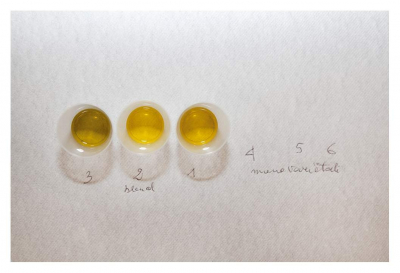Blends in ten steps
Great extra virgin oils originate from the ability to combine various batches of oil. Blending nowadays is the talk of the town, but only few have mastered this art. It is an essential, pivotal operation that plays a key role in characterizing a complex and heterogeneous material such as olive oil

All extra virgin oils originate from olives, but not all olives are the same, for many are the cultivars that have been selected throughout time. Each variety gives rise to an oil with its own distinctive features.
Moreover, there is also another factor that affects the oil, and that is the territory, with its unique microclimate and methods employed to grow the plants, extract the oil and preserve it.
Consequently, the composition and features of the oils can vary extensively from one area to another, so blending becomes necessary to ensure the production of an extra virgin with a standard, well-defined sensory profile.
A blend is the result of great skill and competence. Oil is never bottled as it is. Selections are carried out, and the various batches of oil are mixed together so as to obtain a product that reflects a meditated choice. It is the result of a project, not something improvised.
BLENDS EXPLAINED IN TEN STEPS
1. All extra virgin olive oils, even faultless ones obtained from an accurate pressing process, should always be assessed before being bottled.
2. Even after determining its qualitative profile, the oil should never be bottled as it is: it is always best to choose among the various batches of oil available, to identify the components of the blend one wishes to create.
3. Blending is a necessary practice, because oil is a complex substance, with a variety of sensory features, as well as a multitude of chemical and physical characteristics.
5. Blending produces something that can both meet objective quality standards, complying with the parameters laid down by law, and conform to the producer’s personal concept of oil.
6. A blend is always the result of a well-defined qualitative profile satisfying both qualitative parameters and the needs and demands of the market.
7. Blends cannot neglect the needs and requirements of different types of consumers, because trends change from place to place and person to person.
8. The reasons why the art of blending is not understood or appreciated is the fact that little is known about it.
9. The science of blending is in the hands of a small number of professionals. In the past, very few enterprises believed in blending: these were companies that bottled oil and therefore had to follow the trends of the market and keep abreast with the consumers’ requirements.
10. Now that the number of companies bottling olive oil has grown, it is necessary to train more people in the art of blending.
To comment you have to register
If you're already registered you can click here to access your account
or click here to create a new account


Comment this news